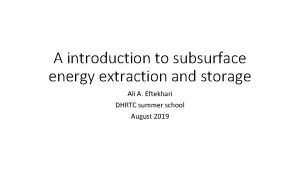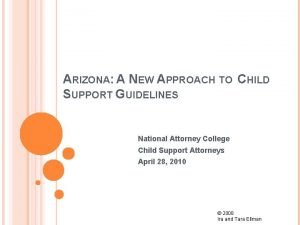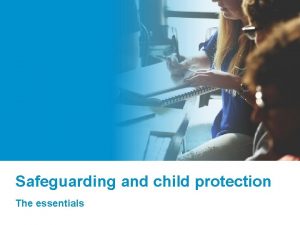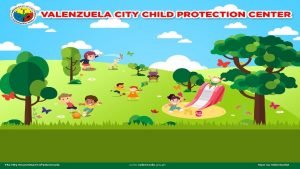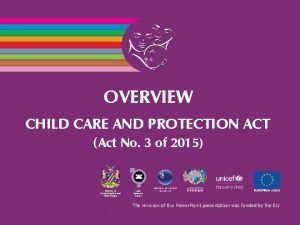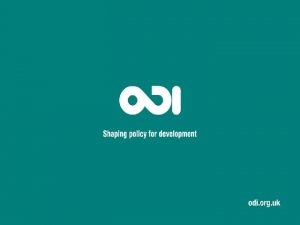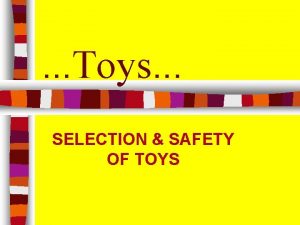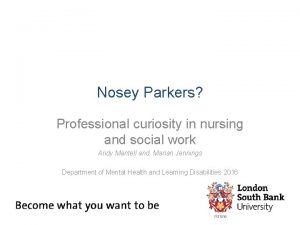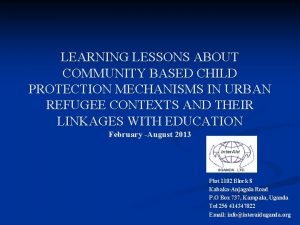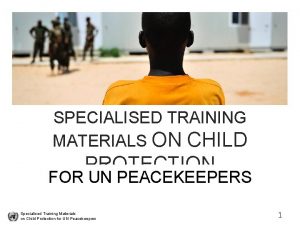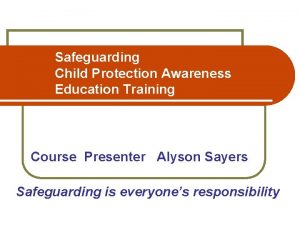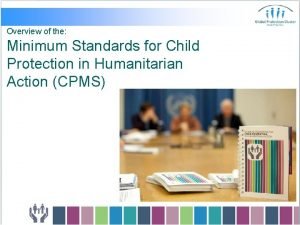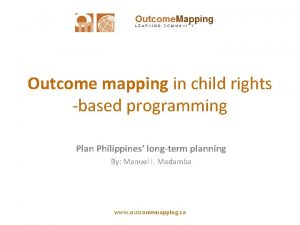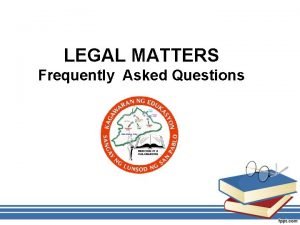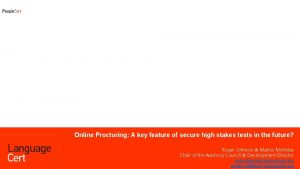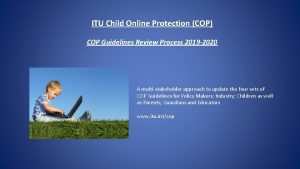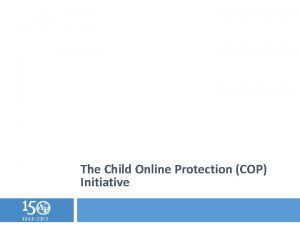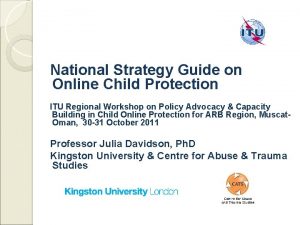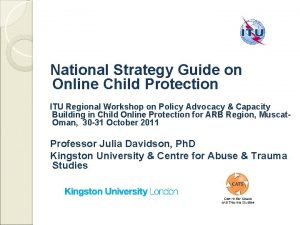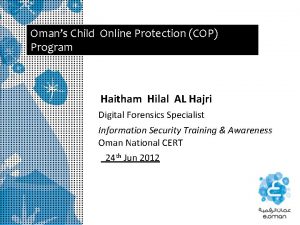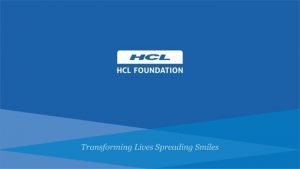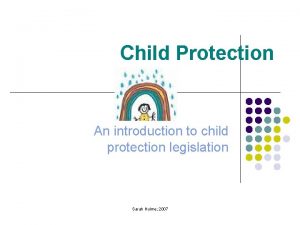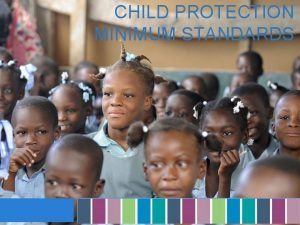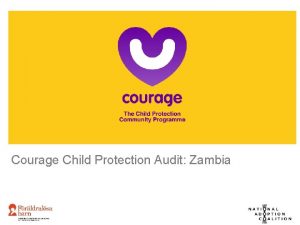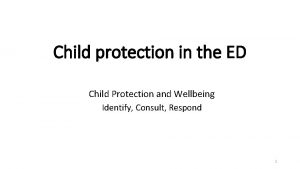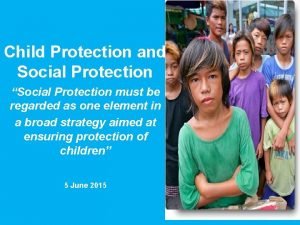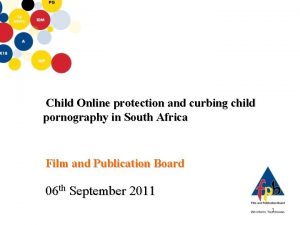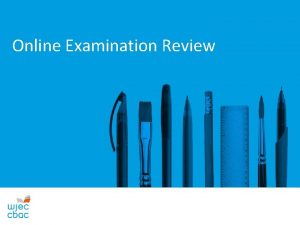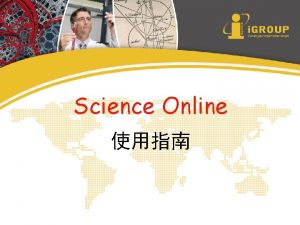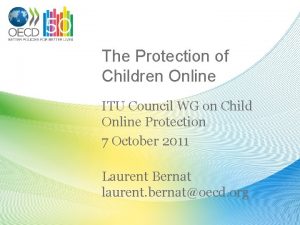ITU Child Online Protection COP COP Guidelines Review




















- Slides: 20

ITU Child Online Protection (COP) COP Guidelines Review Process 2019 A multi-stakeholder approach to update the four sets of COP Guidelines for Policy Makers; Industry; Children as well as Parents, Guardians and Educators www. itu. int/cop

Background and scope According to Resolution 179, ITU in collaboration with COP Initiative partners and COP Partners have been instructed to update the 4 sets of guidelines taking into consideration two main aspects 1. Technology developments in the telecommunication industry 2. Children with disabilities and with special needs The Secretariat is considering including elements related to online gaming, AI technologies – robotics and connected toys as well as different apps and platforms illustrating particular dangers for Children and their well-being such as over user, CSAM, fake news, issues of privacy, digital citizenship and wellbeing etc. The secretariat is considering including a table/checklist in each set of the Guidelines if relevant material will be provided by relevant organizations.

Initial Statements The Working Group on the Guidelines Review Process acknowledges already existing efforts on Child Online Protection and aims to further build on a collaborative and inclusive approach to the issue within the international community. Therefore the Guidelines will refer to existing 1. Models such as e. g. 2. Recommendations such as e. g. Model National Response (Preventing and Tackling Child Sexual Exploitation and Abuse) Report on Child Online Protection and Child Online Safety + Child Online Safety Universal Declaration (Broad Band Commission, 2019) Guidelines to respect, protect and fulfil the rights of the child in the digital environment (Council of Europe, 2018)

Initial Statements The working group further recognizes other international efforts and is informed on 1. Normative developments such as Adoption of an opinion on child sexually suggestive or explicit images and/or videos generated, shared and received by children by the Lanzarote Committee, Days of discussion on the rights of the child online by the UN Committee on the Rights of the Child and the African Committee of Experts on the Rights and Welfare of the Child General Comment on children‘s rights in relation to the digital environment by the Committee on the rights of the child 2. Jurisprudential developments such as e. Safety Commission in Australia New legal framework under New Zealand’s Harmful Digital Communications Act

Process and related working methods Step 1 ✔ Step 2 ✔ 1. Four working groups (one per each Guideline) were 1. The working group identified missing aspects and agreed created, grouping partners and relevant stakeholders according to their interest/field of expertise. 2. Each group nominated a leading organization to on new structures. 2. The inclusion of relevant inputs began and is ongoing. coordinate the substance of the inputs to be included. As 3. The methodology and status of the work is presented at expert in the related field, the leading organization has a the meeting of the CWG COP on September 26 th in ITU, facilitator role in terms of the content to be included in Geneva. the new Guidelines. 3. The subgroups meet virtually every 2 weeks.

Step 3 Step 4 1. The new Guidelines will be drafted by the working group 1. The 4 sets of guidelines will be refined and the final draft including all collected inputs and comments. 2. The first draft version will be submitted as Information Document to the next meeting of ITU Study Group in October 2019. will be prepared. 2. The team will prepare for the next steps.

Time Line Guidelines Review July-December 2019 Step 1 Step 2 Step 3 Step 4

Working Groups 1. Policy Makers - group led by OECD and WPGA • Child Helpline International • In. Hope • RNW Media • Child. Hood USA • INSAFE • Stiftung Digitale Chancen • COFACE-Families Europe • Interpol • Ta. C Together against Cybercrime • Council of Europe • IWF • UK Safer Internet Centre • ECPAT International • Joint Research Centre of the • United Nations Special Rapporteur on the • European Commission • e. Worldwide Group (e. WWG) • Global Partnership to end violence against children • ICMEC European Commission • London School of Economics and Political Science • OECD • Paniamor • Privately SA sale and sexual exploitation of children • United Nations Special Rapporteur on Violence against Children • We. PROTECT Global Alliance (WPGA)

Update on Group 1 Premise: Significant rewriting has to be done. Scope: The document should reflect all risks that children encounter online and not only focus on CSAM. Structure: The content of the old document has been adapted to a new structure. Format: The document may be drafted in the format of a Guide in order to support Governments in their effort to establish a national Child Online Protection Strategy. Responsibilities: The working group is recently identifying responsibilities within the team.

Working Groups 2. Industry – group led by UNICEF • BBC • GSMA • Stiftung Digitale Chancen • EBU • ICMEC • Tencent Games • eset • In. Hope • The Walt Disney Company • e. Worldwide Group • IWF • Facebook • Paniamor • Global Partnership to • Privately SA End Violence Against Children • RNW Media • Trend Micro • Twitter • UNICEF

Update on Group 2 Premise: Revision will be considering inclusion of new categories, restructuring of information and statistics and information update to accommodate more recent technology developments. Scope: The document should reflect all forms of harm that children experience online and not only focus on CSAM. Structure: The content of the old document has been adapted to a new structure. Format: The document will maintain the previous format with checklist for industry but will reorient the structure based on features rather than type of providers. Responsibilities: The working group is recently identifying responsibilities within the team to lead individual sections. There is a proposition of making the guideline more dynamic by having an online format that can be accessed by members to understand who uses it, in what form and to understand the key sections of the guideline that has been effectively applied by the industry.

Working Groups 3. Children – group led by Child Rights Connect/ECPAT International • Child Consultation HABLATAM • Inclusion International • UK Safer Internet Centre • Child Rights Connect • INSAFE • Western Sydney University • Deaf kidz international • Joint Research Centre of the • Youth Crime Watch of Nigeria to • EBU • ECPAT International • e. Worldwide Group • • • European Commission African Centre for Citizens London School of Economics and Orientation Political Science • OHCHR FARO DIGITAL • Polish Safer Internet Center IEEE • Save the Children ( Romania/Finland) • Youth IGF from the Asia-Pacific / Cyberbully. id • @Literacy. Online

Update on Group 3 (part 1) • Premise: Ensure the Guidelines reach, are relevant and used by a wide diversity of children from different age groups • Scope: Incorporate a child rights-based approach and views/concerns from a wide diversity of children from all over the word • Structure: Split of Guidelines into 3, one per age group (5 -7; 8 -12; 13 and above) – – – Preface 1. What is Child Online Protection? 2. Why should you care? 3. Recommendations 4. Further readings • Format: importance of accessibility; possibly in the form of a Comic for the two younger age groups • Content: some key recommendations have been identified; pending the incorporation of recommendations for specific age groups • Consultations: ensure that children have some input into the drafting of the key messages

Update on Group 3 (part 2) Consultations with children - 48 -144 children Participatory method Youth-facing organisations (Yf. Os) to deliver: - Two 3 -5 hours workshop Each with 12 children approx - Recruitment of Yf. Os facilitated by Child Rights Connect and Western Sydney University Children will be recruited by the participating Yf. Os Contributions by a diverse range of children - Two stage consultation: 1. Consultation with 24 -72 children age 8 -12 in December 2019, prior to the finalisation of the draft guidelines for circulation in January 2020, to ensure that children contribute to the definition of the key messaging; 2. Consultation with 24 -72 children age 13 -18 in January 2020 to refine the key messages and language used in the guidelines that are circulated for expert input in January 2020. - Number of children – at a minimum 24 children aged 8 -12 and 24 children aged 13 -18 from two different countries in two separate regions.

Working Groups 4. Parents, Educators and Legal Guardians – group led by INSAFE • COFACE-Families Europe • Insight 2 act • Polish Safer Internet Center • EBU • Internet matters • Save the Children • ECPAT International • Joint Research Centre of the • e. Worldwide Group • FARO DIGITAL • Inclusion International • ICMEC • Paniamor INSAFE • Parentzone International • • (Finland/Norway/Romania) European Commission • Ta. C Together against Cybercrime London School of Economics and • UK Safer Internet Centre Political Science • Youth and Media/ Berkman Klein Center • Youth Crime Watch of Nigeria to African Centre for Citizens Orientation

Update on Group 4 Premise: The content needs to be re-written. Scope: The document should reflect the intersections of different cultures and perspectives. It is important to reflect the global view of the users and take into account cultural sensitivities. Structure: The guidelines should be split into parents/carers/guardians and teachers. Format: The document needs to be accessible for the audience in question. It is currently too long and it is important to recognise that it will not be possible to include everything – – Summary (brief) Data/quotes/facts (referenced and linked) – this could be an info graphic to attract attention Challenges – these could be bullet points Recommendations – bullet points Content/Language: Work has already started on re-writing some of the existing text (new sections/deleted sections). The edits have tried to bring the language and terminology up to date and also reduce the amount of repetition.

Status quo COP Guidelines Review Process The ITU Secretariat facilitated the process by: • Reaching out to colleagues and partners • Establishing the working group and the four subgroups • Leading the election of subgroups leader and briefing the leading Organization • Recruiting additional partners especially experts on the situation of children with disabilities in the digital world • Collecting, structuring and evaluating Inputs • Defining together with the working group new structures for all four sets of Guidelines • Matching existing content to new structures • Drafting an introductory chapter (including purpose, scope, overview and Introduction on COP) • Assigning responsibilities and tasks within the working groups • Coordinating and leading the working group in it‘s joint effort

What‘s next ? 1. Roll-out January-March 2020 • At national level (at least one/two countries per region for each set of Guidelines). • Through questionaries/workshops/case studies/children consultations etc. with concerned stakeholders (policy makers, private sector, children, parents, educators and legal guardians). 2. Official Launch May 2020

Expected Time Line Roll-out + Launch January-May 2020

Many thanks to all Colleagues and Partners for this joint effort www. itu. int/cop
 Good cop bad cop interrogation
Good cop bad cop interrogation Cop 1 cop 2
Cop 1 cop 2 Arizona child support guidelines 2020
Arizona child support guidelines 2020 Safeguarding and child protection the essentials
Safeguarding and child protection the essentials Courage child protection
Courage child protection Types of child protection
Types of child protection Children's rights and responsibilities posters
Children's rights and responsibilities posters Child marriage definition
Child marriage definition Child protection case management tools
Child protection case management tools Types of child protection
Types of child protection Child protection and toy safety act
Child protection and toy safety act Professional curiosity in social work
Professional curiosity in social work Community based child protection mechanisms
Community based child protection mechanisms Child care and protection act 3 of 2015
Child care and protection act 3 of 2015 Child protection training materials
Child protection training materials Child protection awareness training
Child protection awareness training Child protection minimum standards
Child protection minimum standards Child protection policy
Child protection policy Affidavit of two disinterested person
Affidavit of two disinterested person Child protection reform amendment act 2017
Child protection reform amendment act 2017 Biometric assisted proctoring
Biometric assisted proctoring

